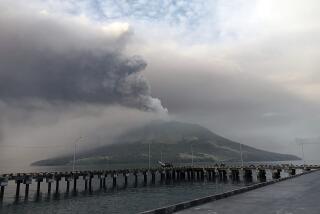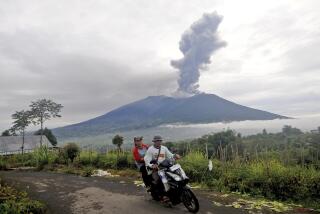Dependable Mt. Usu Spouts Smoke
- Share via
TOKYO — In a spectacular volcanic eruption that sent gray and white plumes of smoke at least 1.7 miles high, Mt. Usu in southwestern Hokkaido began spewing rock, gas and ashes at 1:11 p.m. today, its eighth major eruption since 1663.
A small lava flow was reported to be creeping southward toward the Pacific Ocean, and fine ash fell at least six miles away. But there were no immediate reports of injury.
Mt. Usu has killed at least 68 people in recorded history. But today’s blast had been predicted since Tuesday, and more than 11,000 of the 51,000 residents in three nearby towns had already been evacuated.
An additional 548 people were ordered to evacuate the town of Date within an hour after the eruption. Train service was suspended, highways were closed, and 3,300 of Japan’s Self Defense Forces troops were on standby to help care for displaced residents.
Earthquakes of up to magnitude 4 on the Japanese scale of 1 to 7 were felt. Judging from data gathered during the first half-hour of the eruption, the 2,402-foot volcano’s activity seemed to be much weaker than during its last blast in 1977.
“It is not so big that the top has blown off,” an official at the Meteorological Agency said.
Ash from the 1977 eruption blanketed three towns, causing more than $19 million in damage to farms, roads and sewers, and the next year, three people were killed in volcanic mudslides.
This time, the smoke and gases burst forth on the western slope of the mountain from five different fissures, scientists said. Volcanologist Hiromu Okada of Hokkaido University said he believed that the eruption was triggered when hot magma touched an underground body of water.
Residents said they did not hear any sound when the mountain began to erupt but did feel several tremors.
The Self Defense Forces sent a helicopter over the mountain, but the crew reported that it could not see the eruption itself due to thick smoke. The eruption appeared to be intensifying about 2:30 p.m., when rocks could be seen raining from a cloud of dark gray smoke from 12 1/2 miles away.
Usu, a snow-capped peak 475 miles north of Tokyo, is an extremely rare type of volcano in that its eruptions have been unusually predictable, Okada said. Unlike many “cry wolf” volcanoes that puff and shake but fail to erupt, each of Usu’s seven major eruptions has been preceded by characteristic seismic swarms, and earthquakes have never been reported around the mountain except when it was about to erupt, Okada said.
The pattern is so striking that residents around Mt. Usu were first successfully evacuated before an eruption in 1910, the scientist said. That eruption formed a hot spring that has since grown into a popular resort in the town of Lake Toya, near today’s eruption point. The lava was reported today to be flowing in the opposite direction from the resort, however.
“He is so faithful,” Okada said from his observatory on the side of the mountain in a telephone interview that was interrupted by frequent strong earthquakes. “When he wants to work, he works, and when he wants to sleep, he sleeps.”
More to Read
Sign up for Essential California
The most important California stories and recommendations in your inbox every morning.
You may occasionally receive promotional content from the Los Angeles Times.









